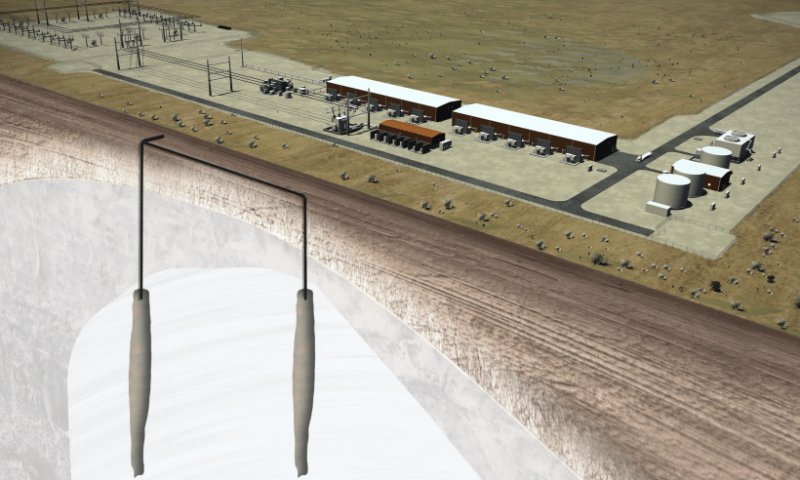Chevron’s latest move into the low-carbon energy business has made it the majority stakeholder of what will be the largest hydrogen storage project in the US upon completion.
Today, the US supermajor announced its acquisition of Magnum Development, which is building the Advanced Clean Energy Storage (ACES) project in Delta, Utah, that is expected to begin commercial operations by the middle of 2025.
Chevron, through its new energies unit formed 2 years ago, purchased Utah-based Magnum for an undisclosed sum to become the project’s new leader alongside existing joint venture partner Mitsubishi Power Americas.
The ACES project will use two massive 4.5-million-bbl salt caverns to store up to 100 metric tons of hydrogen per day. This hydrogen will be generated from surplus solar and wind power through a 220-MW bank of electrolyzers. The produced hydrogen is intended for utilities, industries, and the transportation sector.
Austin Knight, vice president of hydrogen for Chevron’s new energies unit, commented on the acquisition in a statement: "Expansion of the lower carbon-intensity hydrogen supply, along with the development of innovative storage solutions, is critical to the reduction of greenhouse gas emissions. At Chevron, we look for projects that are moving the needle in this respect, and the [ACES] project in Delta, Utah, is an example of a commercially viable project that will help advance a lower-carbon future.”
A Change of Heart
The move to acquire the privately held Magnum comes about a year after Chevron initially passed on an opportunity to take part in the ACES project.
The oil and gas company signaled in September 2021 it was intent on acquiring an equity interest in the project only to walk away from the negotiating table by June 2022. Chevron said at the time that the commercial terms did not meet its required thresholds to move forward.
The step back notably came after the US Department of Energy awarded the ACES project a $504-million loan commitment in June 2022. The government financing was followed up that same month by an additional $650 million in equity funding from Houston-based Haddington Ventures.
The commercial outlook of the ACES project was further boosted when in August 2022 the US signed into law the Inflation Reduction Act which created a maximum tax credit of $3/kg of hydrogen produced through low-carbon methods.
Bigger Than Batteries
The ACES project was designed to take advantage of Utah’s geological salt formations by creating large salt caverns similar to those used for hydrogen storage along the US Gulf Coast.
Houston-based engineering firm WSP, which designed the caverns and wells, said in May that it completed drilling operations and integrity testing ahead of schedule—making them only the fourth and fifth hydrogen storage salt caverns in the US.
The two caverns were built using solution mining, or the “leaching” process, that involves injecting fresh water in depths between 3,000 and 4,000 ft to create a desired void in the salt formation. Planning documents show each of the caverns are designed to be around 220 ft in diameter and 1,200 ft in height.
The resulting nontoxic brine is stored in double-lined evaporation ponds—some of which will eventually be pumped back into the caverns to retrieve stored hydrogen.
Each cavern will be capable of holding 150 GWh of energy, or what Magnum has previously said represents slightly less than all the grid-scale batteries in the world—or the equivalent of three Empire State Buildings full of lithium-ion batteries.
The project’s alkaline electrolyzers will be supplied with groundwater that will be purified and demineralized on site.
Offloading contracts for the anticipated hydrogen production have already been secured by the Intermountain Power Agency (IPA) which supplies electricity to customers across Utah and California.
The IPA has also partnered with Mitsubishi Power on a separate but parallel $2-billion project that involves building a hybrid 840-MW natural gas and hydrogen-burning power plant. With completion scheduled by 2025, the plant’s combined-cycle gas turbines are expected to use a fuel blend containing up to 30% hydrogen, and by 2045 operate on 100% hydrogen.
It is likely that an expansion of the ACES project will be needed to meet the more distant target. Plans for a second phase currently call for two additional storage caverns and 330 MW of electrolyzer capacity, bringing the facility’s total to 550 MW and 250 metric tons of hydrogen per day.
Project developers said last year they expected to break ground on the expansion phase by 2025 but that market demand would ultimately decide whether the work goes forward.


